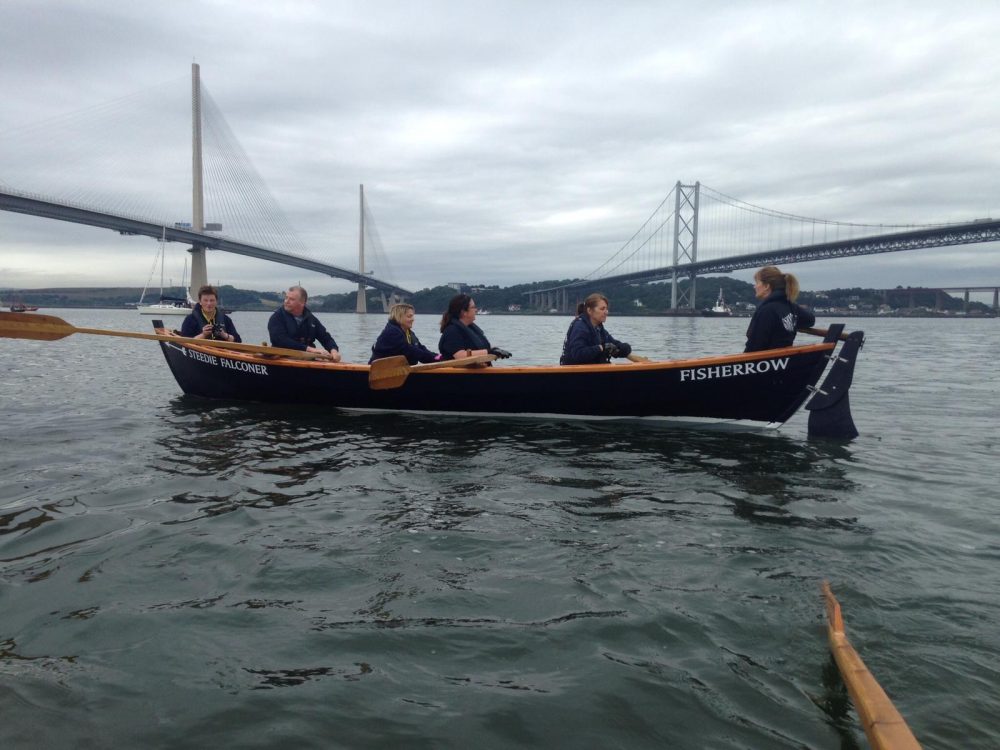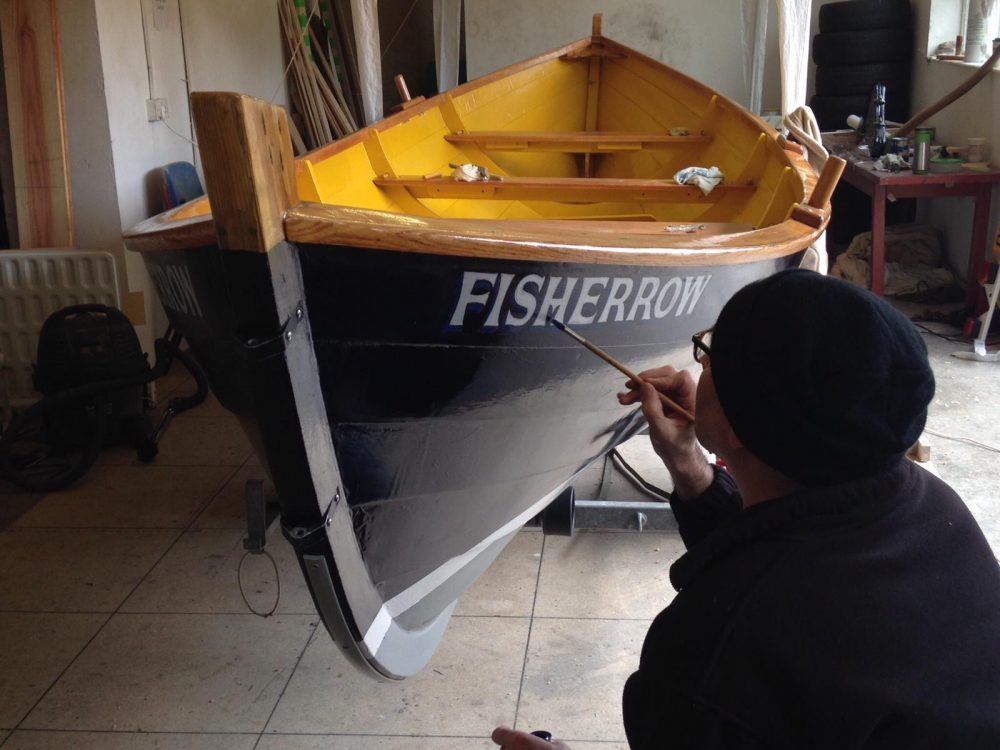Rowers ‘count coast’ of Covid-19 shutdown
Coastal rowing is the fastest-growing sport in Scotland and celebrates its 10th anniversary in 2020 – highly appropriate in the designated Year of Coasts and Waters.
In these strange times, however, no-one is rowing. Although the specially-designed coastal rowing boats – called St Ayles Skiffs – are pretty sizeable (22ft long), it’s hard to get five people in there and maintain social distancing. Especially when you are rowing fast, breathing hard and sweating profusely.
And yet . . . the community spirit of coastal rowing will not be
crushed by Covid-19, and clubs have turned to land-based activities via video
conferencing to get us through the pandemic.
It’s hard to explain to the non-converted why coastal rowing has
‘exploded’ onto Scottish waters and spread throughout the world. At the end of
2010, there were just six boats (four in the Firth of Forth and two in north east
Scotland), and now there are almost 200 boats – most in Scotland, with a very
strong group of clubs in Northern Ireland, a growing fleet in north-east
England and others in the United States, Tasmania, Holland, France, South
Africa and New Zealand.
The rules of most organised sports just don’t apply to coastal
rowing. It is a truly inter-generational sport – at the third coastal rowing
world championship in Stranraer last year, the youngest competitor was 12 and
the oldest 88. There are more rowers between the ages of 50 and 60 than any
other age group, there are more women than men, rowers compete in the gender
they identify with, the rowers build and maintain their own boats, and no-one
in the coastal rowing community is paid. It is all done on a completely
voluntary basis.
So what is it that has so many people hooked? Put simply, four
rowers (with one oar each – two oars on each side of the boat) are guided by a
Cox through whatever conditions the sea has delivered up that day. So you might
go out on a freezing-cold winter morning on a glassy, calm-as-a-millpond sea,
or a sunny summer’s day might throw up a day of waves and swell. Even in local
waters, seals are often spotted – and occasionally, once very memorably,
dolphins dancing in the Forth
“Part of the attraction is that you never know what you will get when you go out,” says Gaynor Allen, Chair of Eskmuthe Community Rowing Club in Musselburgh. “There is something so special about being out on the water, looking back towards where you live, feeling the wind in your hair and the sun on your face, working as a team to move the boat through the water – gliding over the surface or bouncing over the waves.

“Although the rowing is brilliant and really brings people
together, one of the most important club aspects of coastal rowing is a sense
of community. First you have the community spirit in your own club and then the
wider coastal rowing community. There are far less than six degrees of
separation – you can rock up anywhere where there is a rowing club and you will
either know people there, or know others who do. The community spirit is
incredibly strong and you can’t help making friends wherever you go.”
Community club
Clubs regularly travel all over Scotland (and beyond) for
regattas and social rows in the company of fellow coastal rowing clubs.
Although the competitive element is strong, and can be fierce at times, the
friendships made are equally strong.
Eskmuthe has two boats moored at Fisherrow Harbour. The first,
Honesty (named after The Honest Toun), was made by a group of locals who just
wanted to build a boat and formed a club as a result. Most of them hardly
rowed, but many others joined the club and built a second boat, Steedie
Falconer, in 2015. In common with most clubs, Eskmuthe’s second boat was built
by club members with no boat-building experience, using a basic kit supplied by
Jordan Boats.
As Steedie Falconer took shape over the winter of 2014/15 at Prestongrange Heritage and Mining Museum, the club mused over a name. One member came across a story in the local paper saying that one of the last surviving local fishwives, Steedie Falconer, had died while the boat was being made.
“We thought it was a brilliant name for a boat and a great way
to pay tribute to the heritage of the fishwives of Fisherrow,” says Gaynor. “We
spoke to Steedie’s family, who live at Fisherrow, and they were delighted. When
we launched her, Steedie’s daughter, grandson and great-granddaughters came
along, which was amazing. Even more amazing was the fact that the boat was the
95th St Ayles skiff to be built – Steedie Falconer’s age when she died. It just
felt it was meant to be.”

Eskmuthe was named after the mouth (muthe) of the River Esk,
which sits at the point where the two historic communities of Musselburgh and
Fisherrow meet.
“We’re a community club and open to anyone who wants to try out rowing,” says Gaynor, who made a film about The Fishwives of Fisherrow and is working with the Scottish Coastal Rowing Association (SCRA) to make a film about the 10th anniversary of coastal rowing.
The film’s release will be delayed, like everything else in 2020
– while ambitious plans for SCRA members to row around the entire coast of
Scotland have had to be scrapped. However, although the physical rowing can no
longer take place, participating clubs are being creative and doing a virtual
row.
“The plan was to start in the south-west and for all the clubs
to row in legs around the entire coast of Scotland, including the islands,”
said Georgina Brown, Club Captain at Eskmuthe. “This was due to include rowing
along and across the Forth in August and September in company with other clubs
– we might be able to do some of the later parts, but we just don’t know when
we will be back in the boat.”
Boathouse project
Like many rowers, Eskmuthers have been keeping in touch through
obligatory Zoom calls and quizzes, and sharing pictures of rows-gone-by. “We
have built up a great club spirit and people have become very close friends,”
says Georgina. “As well as the rowing, we have a weekly fitness class (which we
were about to make twice-weekly before lockdown hit us), very regular social
events, and a group of club members carry out repairs and maintenance on the
boat, and build oars and other equipment.”
The club has been raising funds to build a boatshed close to
Fisherrow Harbour to carry out year-round repairs and hold small events.
Planning permission has been granted and the club is well-advanced in its
desire to create a sustainable building and a permanent home for the club.

“We think the boatshed will help us grow the club even more,”
says Gaynor, who is leading the project. The club has around 65 members now,
who enjoy a wide range of different rowing options – from social sessions along
the Forth (sometimes stopping for a coffee at Portobello, or occasionally a
beer at the Dalriada before rowing home) to long rows up the Tweed, Tay or
Clyde and fierce competition at regattas near and far.
“We entered the Skiffieworlds (world championships) for the
first time last year and it was an absolutely brilliant experience,” says
Georgina. “The ‘Worlds’ only takes place every three years – in 2013, we didn’t
have a boat and in 2016, it was the Riding of the Marches in Musselburgh and we
wanted to be part of that, as it only happens every 21 years!”
Eskmuthe organised the first-ever Rowing of the Marches shortly before the Riding of the Marches in 2016, with 13 boats taking part in a row-in-company to mark the sea boundaries of the town.
Despite missing the 2016 Skiffieworlds (in Strangford Loch,
Northern Ireland), Eskmuthers have towed and rowed the boats all over Scotland
and beyond made great friends along the way – from Portsoy to Ullapool and from
Glasgow to Fife, and down into Northumberland, including a memorable trip
around Holy Island.
“We’ve had so many brilliant adventures, but the World
Championships was just something else with around 60 clubs and about 2,000
rowers competing over six days last July in Stranraer. We had never been a
super-competitive club, but we trained hard and were delighted to get into a
few finals – but the competition was just one part of a wonderful week full of
camaraderie and fun!”
Gaynor says having fun is at the heart of coastal rowing, as
well as great physical and mental health: “Research by St Andrews University
has shown that coastal rowing has been a huge positive for people in terms of a
new outlet in their life, something that gives people a sense of community and
something which makes them feel physically and mentally healthier. If you
haven’t tried it, I’d urge anyone to give it a go – you don’t have to be
mega-fit. If you want to just take part in social rows, that’s fine but if you
want to compete, then that’s fine too. We can accommodate anybody – the boat is
open to everyone.”
- If you would like to try rowing with Eskmuthe Rowing Club, just email eskmuthe@gmail.com and the club will arrange a session for you when rowing resumes. Check out the club website here: https://www.eskmutherowingclub.org.uk/ or follow the club on Twitter @eskmuthe or Facebook (Eskmuthe Rowing Club). If you would prefer to row closer to home, there are clubs at South Queensferry, Newhaven and two in Portobello, as well as Port Seton, North Berwick and Dunbar in East Lothian
